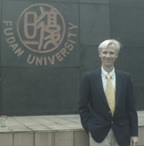Librarian John Hickok’s
Sabbatical in Asia
Hickok looks back
on his travels to Asia
October 10, 2006
By Gail Matsunaga
In July 2005, librarian John Hickok set out across the Pacific for a yearlong
sabbatical in Asia to visit libraries in an effort to better understand
the research needs of international students and help Cal State Fullerton
students negotiate libraries in their studies abroad.
During his travels, Hickok kept the university abreast of his observations and
experiences through monthly
correspondence and photos — posted online.
He assessed more than 200 libraries in 14 countries, including most of the universities
partnered with CSUF. His travels took him to Indonesia, Philippines, Singapore,
Malaysia, Thailand, Myanmar, Laos, Cambodia, Vietnam, China, Mongolia, Korea,
Japan and Taiwan.
“The whole year was absolutely fantastic,” Hickok says. “In
some ways, it seemed so long, but it flew by — probably because I moved
around from country to country.”
From the beginning, Hickok’s goal during his journey and upon his return
was twofold. One is to create brochures for international students attending
CSUF and American students studying abroad. For the international student, the
brochure would be a how-to guide to using our library — explaining cultural
differences, features and expectations of American libraries.
For Titans going abroad, the brochure will aim to tell them what and what not
to expect. “For example,” Hickok explains, “some libraries
have open and browsable shelves, but others have closed shelves, where items
must be requested from staff.”
His second goal is to publish his research in professional journals and in a
book.
Among his many observations, the biggest difference between libraries here and
in Asia, Hickok noticed, is that “U.S. libraries tend to be more actively
involved in workshops and training — not just serve as a study hall.
“Also, the curriculum here demands that students use library research.
In Asia, there’s not as much independent research or independent study.
It’s the nature of the curriculum — it does not promote or lend itself
to active library research to the degree that U.S. universities do.”
Hickok noted that in such industrialized countries as Taiwan, Japan, Singapore,
Hong Kong, South Korea, and pockets of China, including Beijing and Shanghai,
libraries have strong resources. In Japan and South Korea, students can sign
in to the library using their mobile phones, and use touch screen reservation
systems in the lobby for study carrels and group study rooms.
Of all the challenges of living and working abroad, Hickok says, “the hardest
part was the logistics of getting around. For example, taking the train from
Beijing to Ulan Batar. There was no signage in English and I didn’t know
any Chinese. Thank goodness for the Lonely Planet phrase books.”
Interestingly, he says, when his train reached the Mongolian border, it stopped
and one by one, each car’s wheels were removed and replaced with those
that would accommodate the narrow gauge tracks of the now Trans-Mongolian Railroad
tracks.
Among the best experiences, Hickok said, “was working with the U.S. Embassies — their
public affairs divisions — to offer outreach and goodwill. For example,
in Vietnam, the embassy organized a lecture/training session for me to address
dozens of librarians from all over Ho Chi Minh City. This was such a wonderful
experience, because it represented the first time many of these librarians had
ever heard ideas directly from a foreigner. They were so eager and interested
to hear new ideas. The appreciation I saw on their faces was incredibly heartwarming.
Because of the U.S. Embassies, I had the opportunity to give similar lecture/trainings
sessions to audiences in Indonesia, Thailand, Cambodia, China, Mongolia and others.”


 Produced by the Office of Public Affairs at California State University, Fullerton.
Produced by the Office of Public Affairs at California State University, Fullerton.